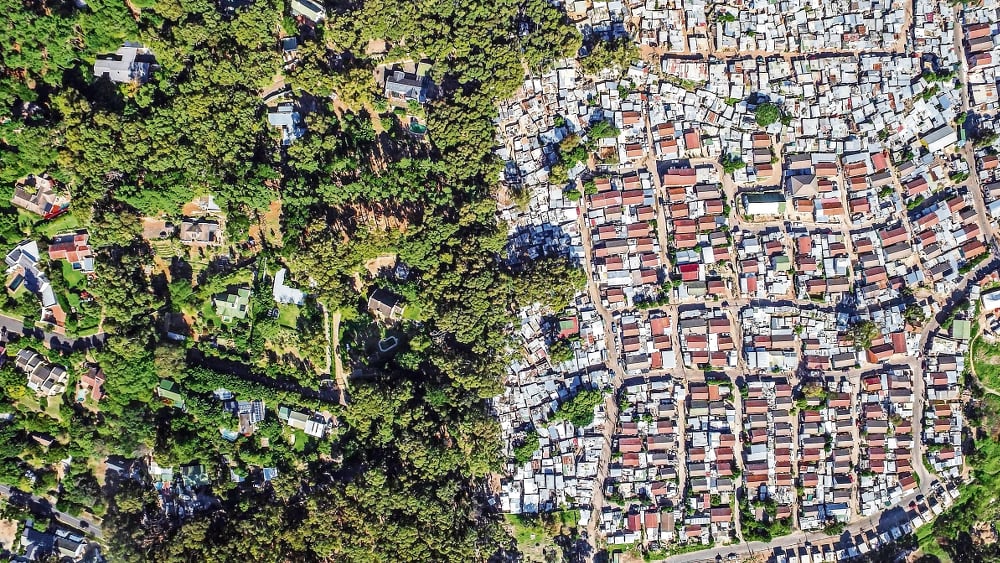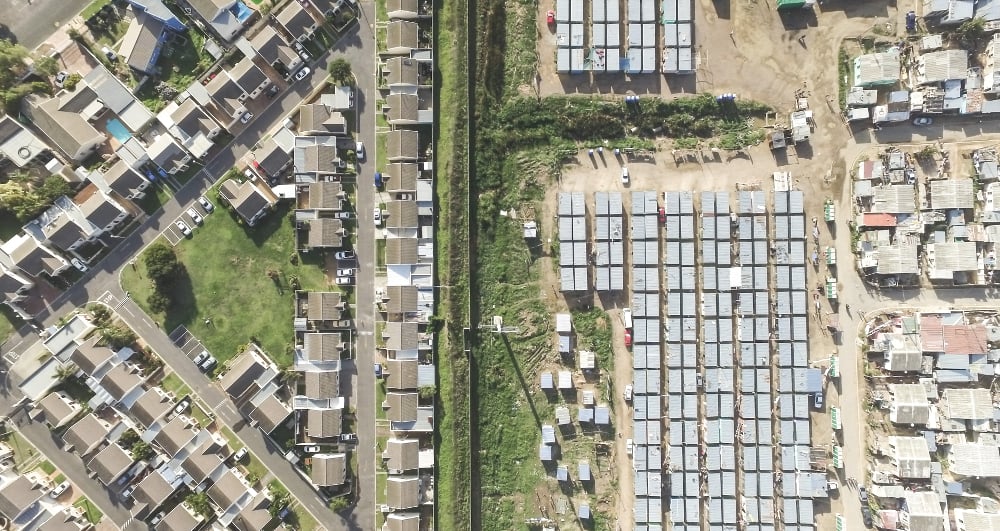Johnny Miller used a drone to take the aerial photographs that highlight the close proximity of poverty and wealth in places like Vukuzenzele and Sweet Home Farm in the Western Cape.
When Seattle photographer and videographer Johnny Miller first arrived in South Africa, the disparity between the rich and poor hit him at eye level.
He was intrigued by just how close together the rich and poor areas were in the Western Cape and was curious to see whether differences were evident from the air.
Miller, who now lives in Cape Town, decided to fly a drone over areas such as Hout Bay and neighbouring Imizamo Yethu. The first aerial image from his series that he shared on his Facebook page in April went viral — receiving more than 1 000 shares. The public’s response took him by surprise. He had had no intention of putting together a large- scale series of his aerial shots, but the feedback encouraged him to ride the wave and make a contribution to the discussion about inequality.
In Johannesburg, it’s startling how two extremely different areas, Alexandra and Sandton — two contrasting communities with different economic backgrounds — are approximately 5km apart. Fancy buildings such as the Michelangelo and DaVinci Hotel in Sandton make up the country’s richest suburban skyline, a contrast to the RDP homes, hostels and informal housing that make up the majority of Alex. This example of inequality is a known sore spot, but at times it seems as though South Africans have become accustomed to it.
The Group Areas Act was implemented to ensure that we lived, worked and “developed’’ separately, according to our races. Today we see inequality in South Africa in the way RDP homes have been built to resemble the matchbox houses that exemplified apartheid South Africa’s social and political disparities in their size and reservation. The shacklands are a reminder that poverty is a reality to many citizens. Division is no longer just based on race but also on social class.

Hout Bay and Imizamo Yethu.
“Everything was very obvious to me but I had almost become accustomed,” Miller told the Mail & Guardian.
“I knew there were some town- ships and other areas that were close to some really rich ones but I hadn’t seen any aerial photography where someone actually documented it. I think someone has probably done it but I just hadn’t seen it before.”
International photographers such as David Wall have also documented class divisions with images of Imizamo Yethu and Hout Bay.
The areas in Miller’s series thus far include Sweet Home Farm, Lwandle, Imizamo Yethu, Somerset West and Strand.
Miller, who has a degree in political science from Dickinson College, was born in the United States but moved to Cape Town four years ago after receiving a scholarship to study anthropology at master’s level at the University of Cape Town. He has since found a home in Cape Town, where he runs his photography and video company, Millefoto.
His previous aerial shots were of the enchanting parts of Cape Town — shots of “beautiful Cape Town roads”, “Catamaran sunset in Cape Town” and the Cape Town Stadium — the kind of photos that entice tourists. But this series speaks to the broader population of South Africa.
A light bulb went on for Miller when a friend pointed out that aerial photography was “an interesting way of taking something that everyone thought they knew how to see and perceive, and putting a completely different perspective on to it”.
Since publishing the photographs on Facebook, he has received praise and criticism from local and international followers. Miller is aware that he could be perceived as “a passive observer of a problem”, which he says is different from being an active participant who is “trying to solve those problems”.

Strand and Nomzamo.
His bird’s-eye view images clearly show how different various areas are. The yards in suburbs are spacious with trees in and around the proper- ties. This contrasts with the treeless light brown mass that is the view of townships.
Being a foreigner trying to zoom in on South African communities has placed Miller in the firing line at times. “One person commented on my Facebook post and said: ‘We know what is happening — everyone in South Africa knows there is a problem and division. You don’t have to rub it in our face. It’s almost as if you are airing our dirty laundry’.
“I guess what I am doing is trying to cross the line from journalism into activism. There has been the age-old debate of whether a photographer or journalist is actually doing anything to solve these problems or if he or she is just paparazzing or trying to make a name for himself or herself and I think that criticism is completely valid,” he said.
“I do believe that by documenting what is happening and provoking people into the firestorm conversations that are happening on my Facebook wall, I’m affecting some sort of change.”
He will release four or five more photos and videos from the series but his dream is to display the images in an art gallery and to create his own website where the series would be able to live.
View Johnny Miller’s inequality series at Millefoto.com